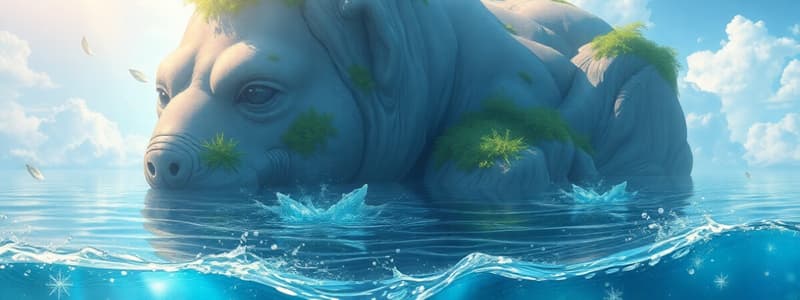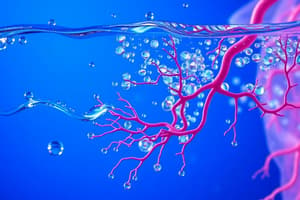Podcast
Questions and Answers
What is the term for moving water or fluids from one place to another?
What is the term for moving water or fluids from one place to another?
- Bulk flow (correct)
- Hydrophobic flow
- Fluid transfer
- Water movement
Why do ions readily dissolve into water?
Why do ions readily dissolve into water?
- Ions are less dense than water
- Heat increases solubility
- Their mass is heavier than water
- Water's polarity (correct)
What happens to fluid mass when salt is added to water?
What happens to fluid mass when salt is added to water?
- Fluid mass and water volume both increase
- Fluid mass decreases significantly
- Water volume increases with fluid mass
- Fluid mass increases while water volume remains unchanged (correct)
What type of channel does Tetrodotoxin (TTX) block?
What type of channel does Tetrodotoxin (TTX) block?
What charge does a cation carry?
What charge does a cation carry?
Which condition can Tetrodotoxin (TTX) lead to?
Which condition can Tetrodotoxin (TTX) lead to?
What surrounds an ion when it's dissolved in water, preventing it from moving freely?
What surrounds an ion when it's dissolved in water, preventing it from moving freely?
Which term describes compounds that repel water?
Which term describes compounds that repel water?
What is a key reason life on Earth takes advantage of water's properties?
What is a key reason life on Earth takes advantage of water's properties?
Which property of water contributes to its ability to dissolve many substances?
Which property of water contributes to its ability to dissolve many substances?
How does the property of surface tension in water benefit certain animals?
How does the property of surface tension in water benefit certain animals?
What happens to the volume of water when it is compressed?
What happens to the volume of water when it is compressed?
What occurs to water when heat is added in terms of hydrogen bonds?
What occurs to water when heat is added in terms of hydrogen bonds?
Why is water considered a 'great heat sink'?
Why is water considered a 'great heat sink'?
What major adaptation might animals living under large volumes of water need to cope with?
What major adaptation might animals living under large volumes of water need to cope with?
What essential ability must organisms have to regulate their internal conditions?
What essential ability must organisms have to regulate their internal conditions?
What causes oil and water to not be readily miscible?
What causes oil and water to not be readily miscible?
What is produced when CO2 reacts with water?
What is produced when CO2 reacts with water?
What primarily dictates the movement of water across a barrier?
What primarily dictates the movement of water across a barrier?
What is the relationship between major and minor ions?
What is the relationship between major and minor ions?
What effect does a salt wedge or halocline have on life in estuaries?
What effect does a salt wedge or halocline have on life in estuaries?
What happens to water movement when there is a difference in concentration gradients?
What happens to water movement when there is a difference in concentration gradients?
Which condition is essential for cellular membranes to maintain structure?
Which condition is essential for cellular membranes to maintain structure?
What term is used to describe the total concentration of solute particles in a solution?
What term is used to describe the total concentration of solute particles in a solution?
Flashcards are hidden until you start studying
Study Notes
Concepts of Water in Zoology
- The relationship between an animal and its environment is interconnected; changes in the environment affect organisms.
- Organisms must regulate internal conditions through homeostasis, despite environmental changes.
Homeostasis and Water
- Water is essential for life, characterized by unique properties such as structure, polarity, liquid and solid forms, and hydrogen bonds.
- Acts as a heat sink, absorbing and retaining heat, which is crucial for maintaining stable temperatures.
Unique Properties of Water
- Water is incompressible and viscous, preventing free spaces and affecting how animals adapt to pressure in aquatic environments.
- Dissolves a wide variety of substances, including ions and gases, making it a vital medium for biochemical reactions.
Surface Tension and Biological Interfaces
- Water exhibits surface tension, creating interfaces that support life forms, such as the mosquito and the Jesus Christ Lizard, which can walk on water.
- The surface tension reacts to force; greater force creates higher resistance, allowing certain animals to navigate this interface effectively.
Water and Temperature Regulation
- Water has a high latent heat of vaporization, allowing it to absorb significant amounts of heat energy, which plays a role in sweating and temperature regulation in life forms.
- This property is fundamental for ecosystems, as it helps regulate temperature across environments.
Pressure and Adaptations in Aquatic Animals
- Aquatic organisms adapt to high-pressure environments, where gas solubility in water increases under pressure.
- Example: Divers must manage decompression sickness (the bends) when ascending.
Viscosity and Energy
- Moving water requires energy; bulk flow refers to the movement of fluids from one location to another, significant for various biological processes.
Ionic Dissolution in Water
- Water typically contains dissolved ions, which are categorized as anions (negatively charged) and cations (positively charged).
- The polarity of water facilitates the dissolution of these ions, forming hydration shells that influence biological functions.
Sodium and Hydration Shells
- Adding salt increases fluid mass without increasing water volume due to the ordering effect of water around ions.
- Tetrodotoxin (TTX) in some organisms blocks sodium ion channels, demonstrating the importance of ion movement in cellular processes.
Hydrophobicity
- Non-polar compounds like oil do not mix with water, leading to hydrophobic interactions critical for cellular membrane integrity.
Carbon Dioxide and Bicarbonate Formation
- CO2 dissolves in water, allowing for the formation of bicarbonate ions, crucial for maintaining pH balance in biological systems.
Ion Concentration in Estuaries
- Estuarine environments display gradients in salinity, presenting challenges for organisms that must adapt to varying salt concentrations.
Measuring Solutes in Water
- Two primary methods exist for quantifying solutes: molarity (M) for individual amounts and osmolarity (Osm) for aggregate amounts in solutions.
Movement Across Membranes
- Water and ion movement across barriers follow gradients; substances naturally move from areas of higher concentration to lower concentration, affecting osmolarity.
- Understanding osmolarity is critical for predicting water movement in biological systems, especially in varying environments like freshwater and seawater.
Studying That Suits You
Use AI to generate personalized quizzes and flashcards to suit your learning preferences.




